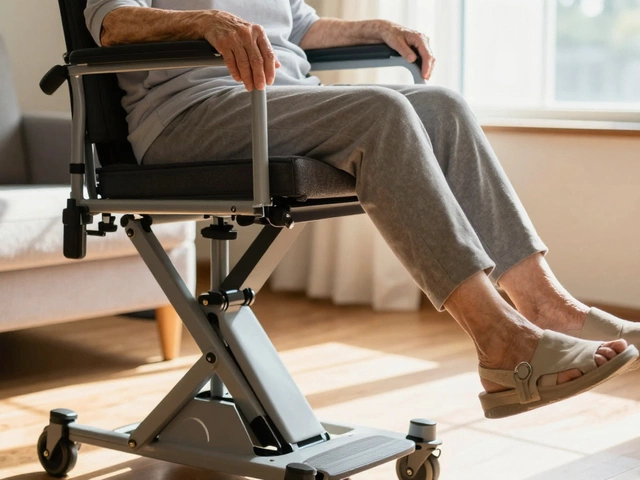Office Chair Guide: Comfort, Height & Longevity
Spending hours at a desk can turn a good chair into a pain in the back if you don’t pick the right one. Below you’ll find simple steps to choose, set up, and keep an office chair that supports you day after day, without breaking the bank.
How to Pick the Right Office Chair
First, think about the basics: seat depth, backrest shape, and adjustability. A seat that’s too shallow will make you slide forward; too deep and you’ll slouch. Sit all the way back and see if you can press your feet flat on the floor – that’s a good sign. Look for a chair with a lumbar support that follows the curve of your lower back; a small pillow‑like pad can do the trick if the built‑in one feels flat.
Next, check the armrests. If you need them for typing, they should sit just a few centimeters above your elbows. Some people remove them entirely for a freer movement range – that’s fine as long as your shoulders stay relaxed. Finally, test the swivel and casters. The chair should turn smoothly without wobbling, and the wheels need to roll on your floor type (hard‑wood, carpet, or tiles) without scratching.
Setting Your Chair for Ideal Height and Posture
Adjust the seat height so your knees bend at about a 90‑degree angle and your thighs stay parallel to the floor. A quick trick: sit with your feet flat, then press the lift lever until your hips are just a little higher than your knees. Your elbows should also rest at a 90‑degree angle when your hands rest on the desk. If the desk is too high, raise the chair a bit; if it’s too low, lower the chair until the alignment feels natural.
Don’t forget to tilt the backrest. A slight recline (around 100‑110 degrees) takes pressure off the spine and encourages a healthier posture. Most chairs let you lock this angle in place – use it while you’re focused on reading or brainstorming. When you need to type fast, straighten the back a little to keep your arms close to your body and avoid shoulder strain.
Maintaining Your Chair for Years of Use
Even the best office chair will wear out if you ignore basic care. Start by wiping the seat and backrest with a damp cloth every week; dust builds up and can ruin the fabric or leather. For fabric chairs, a quick vacuum with a brush attachment removes crumbs and pet hair. If you have leather, use a conditioner once a month to keep it supple and avoid cracks.
The moving parts need attention too. Check the gas lift cylinder for leaks – if the chair sinks slowly, the cylinder is likely worn and should be replaced. Tighten any loose screws on the base and armrests every few months. Lubricate the swivel mechanism with a few drops of silicone spray if it starts to feel stiff. Replacing worn casters with new ones (choose rubber for carpet, hard‑plastic for wood) can extend the chair’s life dramatically.
Finally, think about the load you put on the chair. Most office chairs are rated for 250‑300 lb; exceeding that limit speeds up wear on the frame and the gas lift. If you know you’ll be on the heavier side, look for a chair specifically built for higher weight capacity – the extra reinforcement is worth the small price jump.
By following these simple steps – pick a chair that fits your body, set the height and tilt correctly, and keep it clean and tightened – you’ll enjoy a comfortable, supportive seat for many workdays ahead. No need for costly replacements or constant backaches; a well‑chosen office chair does the heavy lifting for you.
How to Flatten Your Stomach While Sitting: Real-World Tricks for Office Chairs
Sitting at a desk can sabotage your efforts to flatten your stomach, but it doesn't have to. This article breaks down practical and doable ways to work on your core while you sit at work—without turning your desk into a gym. You’ll find out which postures, movements, and tiny habits can help you out, plus facts about how your chair plays a sneaky role. Whether you’re at your desk eight hours a day or just stuck in traffic, these tips cut through the noise so you can actually see results. Get ready to rethink what you can do for your abs while you sit.
Office Chairs: To Arm or Not to Arm?
Choosing between an office chair with or without arms can impact your comfort and productivity. Whether you're working from home or at the office, understanding the pros and cons of each option will help you make a more informed decision. This article explains the benefits and drawbacks of both types, along with practical tips to enhance your work environment. Gain insights to align your seating choice with your needs and preferences.
Comfortable and Ergonomic Chairs for Long Work Sessions
Finding the right chair for long hours at the desk involves considering ergonomics, adjustability, material, and personal needs. This guide explores the significant features that make a chair comfortable and supportive for extended sitting. We'll dive into staple designs and share insights on how to pick a chair that maintains good posture and alleviates the strain. Armed with these tips, making an informed decision becomes as easy as a good stretch mid-day.









